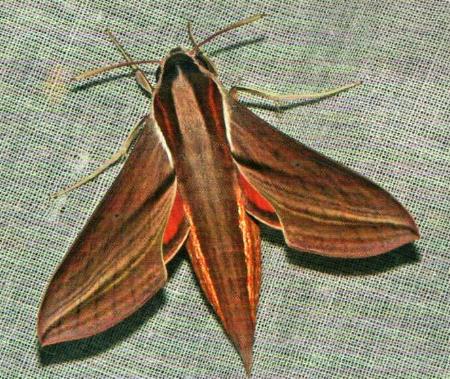
| (one synonym : Sphinx vampyrus Fabricius, 1787) MACROGLOSSINAE, SPHINGIDAE, BOMBYCOIDEA | (donherbisonevans@yahoo.com) and Stella Crossley |

Photo: courtesy of Buck Richardson, from
Tropical Queensland Wildlife from Dusk to Dawn Science and Art

| (one synonym : Sphinx vampyrus Fabricius, 1787) MACROGLOSSINAE, SPHINGIDAE, BOMBYCOIDEA | (donherbisonevans@yahoo.com) and Stella Crossley |

Photo: courtesy of Buck Richardson, from
Tropical Queensland Wildlife from Dusk to Dawn Science and Art
The first instar Caterpillars of this species are initially green, with a yellow head, a yellow spots on the side of each segment, and a straight dark tail spike.
Later instars are basically black or dark brown, including the head, with a yellow line each side from the head to the first eyespot, and another from the last eyespot to the tail-spike and down the claspers. The eyespots are yellow, with a brown blotch in the lower half, and a straight upper edge. The eyespots on the first abdominal segment contain pale dots. The tail spike is long and black, with a reddish base and a white tip.
In Australia, the caterpillars have been found feeding only on
The caterpillars can be found by seeking the results of their characteristic feeding beviour. Early instars eat a hole in the middle of a foodplant leaf. Later instars eat a leaf-blade from the tip, leaving it cut squarely across.
The caterpillars grow to a length of about 8 cms. Pupation occurs in a loose cocoon amongst the leaf litter. The pupa is brown with a dark spot on the side of each segment, and a broken dark line along the back and the underside. The pupa has a length of up to 4 cms.
The adult moths have brown forewings with a central pale stripe from base to wingtip. The hindwings are red with dark brown outer margins, and pale brown hind margins. The wingspan is about 6 cms.
The eggs are pale green, and ovoid with a length of nearly 2 mms. The eggs are laid singly on the upper surface of a foodplant leaf.
The species is found across south-east Asia and the south-west Pacific, including :
and in Australia in
Further reading :
Ian F.B. Common,
Moths of Australia,
Melbourne University Press, 1990, p. 415.
Johan Christian Fabricius,
Historiae Naturalis Fautoribus,
Systema Entomologiae,
1774, p. 542, No. 22.
Maxwell S. Moulds, James P. Tuttle and David A. Lane.
Hawkmoths of Australia,
Monographs on Australian Lepidoptera Series, Volume 13 (2020),
pp. 129-132, Plates 27, 77, 87.
Buck Richardson,
Tropical Queensland Wildlife from Dusk to Dawn Science and Art,
LeapFrogOz, Kuranda, 2015, p. 201.
 caterpillar |  butterflies |  Lepidoptera |  moths |  caterpillar |
(updated 5 January 2007, 5 March 2023)